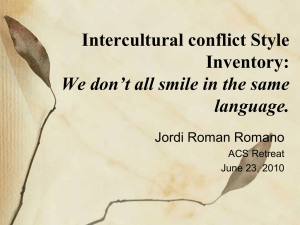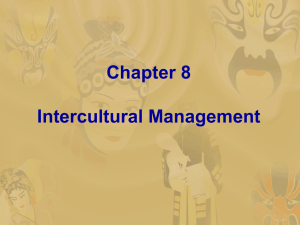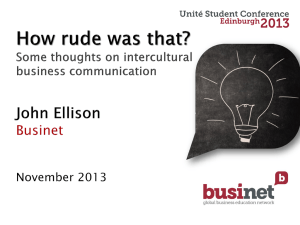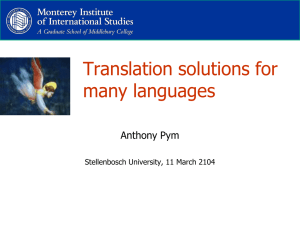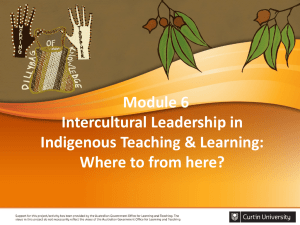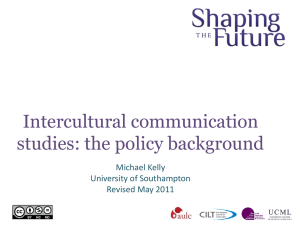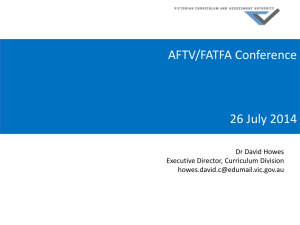handout
advertisement
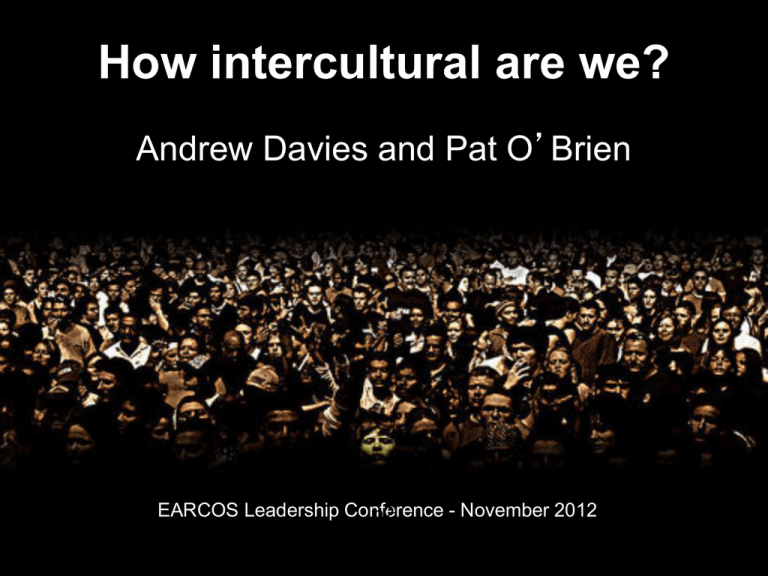
How intercultural are we? Andrew Davies and Pat O’Brien EARCOS Leadership Conference - November 2012 n2 1.How intercultural are we? o o What is intercultural sensitivity? Research in international schools Students Faculty 2.Intercultural by design o o o Outcomes, frameworks, practices, curriculum, programs Engagement and intercultural skills matrix Take aways “…sensitivity to the importance of cultural differences and to the points of view of people in other cultures” (International Journal of Intercultural Relations, 1992). • A common aim of international schools is provision of intercultural sensitivity (ICS) as an aspect of the international education that the schools provide. • Surprisingly, very little research has been carried out to ascertain the level of ICS among the members of international schools. • Pedderson (1998) measured ICS among middle school students inthe US. • Straffon (2001) measured ICS among high school students at the International School Kuala Lumpur. • Westrick (2002) examined the impact of service learning on the degrees of ICS among high school students at a Hong Kong international school. • Mahon (2003) measured ICS among teachers in the Midwest • Westrick & Yeun (2007) measured ICS among teachers in HK • O’Brien (2007 unpublished) explored the relationship between ICS among high school students and school practices. • Davies (2010) measured ICS among teachers at the Bennett’s Developmental Model of Intercultural Sensitivity • “ethnocentric” a worldview that assumes one’s own culture is central to all reality • "ethnocentrism" parallels ‘egocentrism’. • includes attitudes such as racism, cultural superiority, and an ‘us against them’ view of the world. Worldview: Narrative: No categories or broad categories of cultural difference marked by: • Denial/Disinterest • Denial/Avoidance • • • • I never think about racism Live and let live All big cities are the same My main concern is getting around town and ordering food • I never experience culture shock Worldview: Narrative: Better recognition of cultural difference coupled with negative valuation compared to native culture: • Defense/Denigration • Defense/Superiority • Defense/Reversal • This is all just PC • I wish these people would just talk the way we do • These people don’t value life the way we do • I’m embarrassed by my compatriots • I wish I could give up my cultural background and… Worldview: Narrative: Stability is maintained by • Talking about race subsuming difference into reinforces racism familiar categories: • All the race that matters is • Human Similarity the human race • Transcendent • Technology brings cultural Universalism uniformity • It’s a small world, after all • Ethnorelative stages apply to people that see their own culture in a greater context involving other cultures. • Cultural difference viewed neutrally, although does not imply all cultural differences are agreed with. Decisions are actions are not based on a perceived threat. • In Ethnorelative stages, cultural difference is nonthreatening and may actually be preferred and aspired to by people in these stages. Worldview: • Cultural self awareness • Recognition and appreciation of cultural differences • Respect other’s values and beliefs • Tolerance of ambiguity Narrative: • The more difference the better • The more cultures you know about the better comparisons you make • Sometimes it’s confusing, knowing values are different, but maintaining my core values Worldview: • Conscious shifting of perspective – cognitive empathy • Acting in culturally appropriate ways – intuitive empathy • Bicultural behavior shifts without much effort Narrative: • To solve disputed I have to change my approach and/or change my behavior • I can maintain my values and behave in culturally appropriate ways • I’m beginning to feel like a member of this culture • I get the language Worldview: • Seeing oneself “in process” internalizing bicultural or multicultural frames of reference • Experience or Acceptance of an identity that is not based on any one culture Narrative: • Everywhere is home • I feel most comfortable bridging cultures • Whatever the situation, I look at different perspectives • I enjoy participating in both of my cultures • My decision making is enhanced by multiple frames of reference How intercultural are_______? • The purpose of this study was to ascertain the usefulness of the Intercultural Development Inventory in measuring the intercultural sensitivity of a sample of teachers at the International School Bangkok. Example IDI Report • 86 teachers in 2008: o Mean = Minimization o 15% in Denial/Defense o 17% in Acceptance/Adaptation • Positive correlations with: o Gender (female) o Experience living in other cultures o Knowledge of a foreign language o Professional development Interested in exploring intercultural sensitivity and student perceptions: • Current levels of intercultural sensitivity (ICS) among high school students • Relationship of gender, nationality, years at ISB, years in international school, years living in another culture, mother’s educational level, and father’s educational level and ICS. • Students’ perceptions of key influences of the school on development of ICS • Three instruments used: o Intercultural Development o Student Questionnaire o Semi-structured interview Inventory Gender Nationality Program DS Score Dev Level F Malaysian IB 82.1 Def Ethnocentric M Japanese Standard 85.3 Def Ethnocentric F Japanese Standard 86.1 Def Ethnocentric M American Standard 95.9 Min Ethnocentric M American Standard 98.3 Min Ethnocentric F Canadian IB 101.1 Min Ethnocentric F Japanese IB 105.3 Min Ethnocentric F American Standard 115.7 Acc Ethnorelative M Thai IB 125.3 Acc Ethnorelative M American IB 126.3 Acc Ethnorelative Ethnocentric Ethnorelative Number of Students Female = 4 Male = 3 Female = 1 Male = 2 Years International School Range 5-13 years AVG = 7.6 years Range 10-13 AVG = 11.7 Years Outside Home Country Range 5-15 AVG = 9.6 Range 2-15 AVG = 9 Number of Languages Range – 1-3 AVG = 2 Range 2-3 AVG = 3 Mother’s Educational Level AVG = 12 AVG = 14 Father’s Educational Level AVG = 12-9 AVG = 13.3 Ethnocentric Ethnorelative Most important parts of vision/school influences: Engagement with other in school Teachers Curriculum Engage with other outside of school Leadership & School Ethos Engagement with other outside of school Engagement with other in school Teachers Curriculum Leadership & School Ethos Top Five Practices/Programs Languages Week Without Walls Community Service World Civilization Modern World History Week Without Walls Community Service World Literature History Cultural Convention Experiences Outside of Classroom Living in Bangkok city Everyday interaction w/Thai School Environment Friends Sports School Environment Friends Travel Clubs Community Service How intercultural are we? •Purpose •Pillars •Platforms •Progress •Pulpit “To change our worldview, we first need to become conscious of having one.” Mark Gerzon Developing intercultural competence involves combining • skills that build intercultural understanding and sensitivity, with • learning experiences that involve engagement with other cultures, and • guided by developmental considerations. O’Brien 2012 . Engagement HIGH LOW HIGH Intercultural Skill LOW O’Brien 2012 • Find a hundred mission statements of international schools and the chances are that almost all of them will claim to promote international understanding, worldmindedness, global perspectives, intercultural sensitivity, and so on. “Time spent on inservice training for faculty is necessary to ensure that teaching is responsive to the learning styles of a diverse student body. Determining the level of intercultural sensitivity of the faculty is a first step toward increasing faculty awareness of the importance of their role in modelling intercultural sensitivity. Unless the faculty is consciously teaching inclusive values, and providing experiences for positive cross-cultural interaction for students, and any explicit statement by the school regarding the value of diversity will be for naught” (Straffon, 2003). Studies support a positive influence of PD on ICS: • DeJaeghere & Zhang (2008) used the IDI for baseline data, followed up with ICS training (IDI professionals) and conducted post tests • Postitive and significant improvement for those that underwent training Teachers • Culturally diverse classrooms are the norm in most international schools and are becoming more frequent in many national schools. To help students reach their potential, “teachers must be aware of cultural difference beyond the immediately visible surface aspects of the so called 4Fs – fashion, festivals, flags and food. They need to be sensitive to the less visible aspects of culture, such as teaching and learning philosophies, communication styles, beliefs and values” (Snowball, 2007, p.250). • • • • • Possible to use the IDI in recruitment $10 per survey 20 minutes to complete and score But....ethical implications and potential reliability issues Suggested - adapt questions from IDI to ask such as: "On the whole do you think that people from different cultures are essentially the same?" Social Studies “Over the last few years, I have been involved with curriculum work at my school, trying to create a more global focus for our social studies programme. My search for exemplars was frustrating as I found most international schools similarly focused upon the American and British models of social studies education, with a distinct avoidance of the contemporary world. The vast majority of international school teachers come from the U.S. and the U.K. and are products of their own upbringing, training and experience. The resources that they choose for their classes are predominately American or British, as are the external examinations that they use to help their students gain university admission" (Lewis, 2005) IB DP The ‘international’ aspects of the IB program are welcome, but the degree of them depends to some extent on the teachers and schools that provide them. “It is clear that the IB has great strengths, but the amount of internationalism in a program depends on which combination of subjects a student may choose. This leads us to a feeling that it just misses the target of a truly comprehensive global program for all” (Jenkins 1998) ISB Framework: Continuum ISB Framework: 5 Strands • Social Justice • Identity & Diversity • Interdependence • Sustainability • Peace and Conflict Week Without Walls Global Citizenship Week Tsunami Relief Elephant Sanctuary in Chiang Mai Skiing in the Alps Paris: City of Lights Tanzania: Service & Safari Rafting Painters with a Conscience Life on the Mekong Take away practical ideas • Intercultural by Design • Appoint a "Global Issues & Service Coordinator" • Design and Implement global citizenship and intercultural competence curriculum • Book Clubs for interested teachers • Hire teachers with high intercultural engagement • Conduct PD over time that addresses ICS (using the IDI) • Implement comprehensive community service • Develop strong modern language and MT programs • Ensure strong cultural aspects in classrooms • Develop celebrations • Design activities with an eye toward engagement, skill building • Programs - WWW, MUN, cultural clubs, service, Final Word Borrowing the words of Walker (2004), more than the “rubbing of shoulders’ is necessary.
